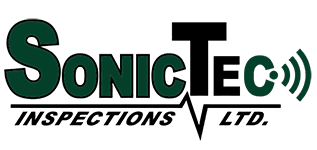SonicTec Non-Destructive Testing Services
Qualified inspections carried out on site with actionable reports for your technicians to keep your business running
Visual Inspection
Visual Inspection, or Visual Testing (VT), is the oldest and most basic method of inspection. It is the process of looking over a piece of equipment using the naked eye to look for flaws. It requires no equipment except the naked eye of a trained inspector and maybe a few measuring tools. Compared to other methods, it is far more cost effective. This is because there is no equipment that is required to perform it. For similar reasons it also one of the easiest inspection techniques to perform. It is also one of the most reliable techniques.
Hardness Testing
Sonictec is capable to perform hardness tests with the use of an Ultrasonic portable hardness tester UCI Method (ultrasonic Contact Impedance)
Ultrasonic hardness testing is widely used to measure hardness of flange edges, stamped parts, molds, sheets, hardness of the shaft, pipe including inside and outside wall, container, wheel, turbine rotor, HAZ weld, injection molding machine screw parts etc. The measurement results can be analysed on location directly on the device. It is also possible to reassess the data in accordance with EN ISO 18265, DIN 50150 and/or ASTM E140 for use with prevalent hardness scales such as Vickers, Brinell, Rockwell.
Positive Material Identification
Positive Material Identification (PMI) quickly and accurately identifies the composition of more than 100 different engineering alloys and chemical composition through non- destructive methods, by reading the quantities by percentage of its constituent elements. We can perform PMI on virtually any size or shape of pipe, plate, weld, welding materials, machined parts or castings with the use x-ray fluorescence (XRF)
PMI can be conducted on-site or in shop and is a useful test for:
- Testing a part of an assembly or an item that is too large for shipping
- Testing materials in which a sample cannot be cut because they are too costly to destroy
- Testing a lot suspected to be mixed
- Material identification / documentation has been misplaced.
Mobile Equipment Inspection and Certification
SonicTec Inspection ltd. uses a reputable engineering firm to certify equipment. Our engineer has over 20+ years’ experience with expertise in fabrication repairs. This experience is suited to the review of Crane and lifting equipment inspections as well as the review and design of any required repairs. Our engineer is registered as professional engineers in, Alberta, Manitoba, and Saskatchewan.
We Inspect:
- AWP (Aerial Work Platform)
- Crane
- Forklifts
- Zoom Boom
- Spreader Bars
- Man Basket
- Pipelayers
- Articulating Cranes
- Boom Trucks
- Digger Derrick
- RT Cranes
- Carry Decks
- And more …
UT Shear Wave Inspection
Ultrasonic Testing (UT) uses high frequency sound energy to conduct examinations and make measurements. Ultrasonic inspection can be used for flaw detection/evaluation, dimensional measurements, material characterization, and more; UT detects flaws, is portable and non-hazardous. Another Ultrasonic technique used is shearwave, also known as an angle beam inspection that is great for weld inspections.
Magnetic Particle Testing
Non-Destructive Testing (NDT) process for detecting surface and shallow subsurface discontinuities in ferromagnetic materials such as iron, nickel, cobalt, and some of their alloys. The process puts a magnetic field into the part. The piece can be magnetized by direct or indirect magnetization. Detects surface cracks.
Liquid Penetrant Testing
Liquid Penetrant testing (a widely applied and low-cost inspection method used to check surface-breaking defects in all non-porous materials (metals, plastics, or ceramics). The penetrant may be applied to all non-ferrous materials and ferrous materials, although for ferrous components magnetic-particle inspection is often used instead for its subsurface detection capability.
LPI is used to detect casting, forging and welding surface defects such as hairline cracks, surface porosity, leaks in new products, and fatigue cracks on in-service components
#4-419 Kensington Ave, Estevan, SK S4A 2A7, Canada
Estevan Office
306-634-3998
Regina-Wayne
306-421-3312
Estevan-TJ
306-421-3312
